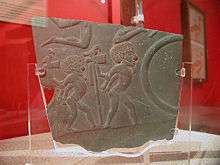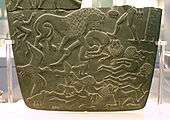Battlefield Palette


The Battlefield Palette (also known as the Vultures Palette, the Giraffes Palette, or the Lion Palette)[1] may be the earliest battle scene representation of the dozen or more ceremonial or ornamental cosmetic palettes of ancient Egypt. Along with the others in this series of palettes, including the Narmer Palette, it includes some of the first representations of the figures, or glyphs, that became Egyptian hieroglyphs. Most notable on the Battlefield Palette is the standard (iat hieroglyph), and Man-prisoner hieroglyph, probably the forerunner that gave rise to the concept of the Nine Bows (representation of foreign tribal enemies).
The palettes probably date mostly from the Naqada III (ca. 3300–3100 BC),[2] i.e. late predynastic period, around 3150 BC.[3] The two major pieces of the Battlefield Palette are held by the British and Ashmolean Museums.
The Battlefield Palette, two fragments


The Battlefield Palette obverse contains the circular defined area for the mixing of a cosmetic substance. It contains the battlefield scene, and forerunners of hieroglyphs: prisoner, tribal-territory wooden standard, the horus-falcon and an ibis bird resting on standards. The fractured lower half of the prisoner on the obverse right may have a hieroglyph at his front (the rectangle, as rounded for land) with suspected papyrus plants attached on top.
The reverse of the palette has dramatically stylized versions of a bird, two antelope-like mammals, a vertical palm-tree trunk, a partial top with fruits, and short horizontal palm fronds.
See also
References
External links
| Wikimedia Commons has media related to Battlefield Palette. |
- 3rd fragment, and other Ancient Egypt palettes and Eras Edition 8, November 2006
- Front: the 2-joined pieces
- Reverse
- Photo and graphic of 3rd piece (Lucerne fragment)
- Article, front side graphic, and Synoptic analysis of Battlefield Palette